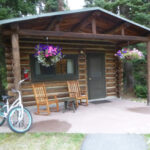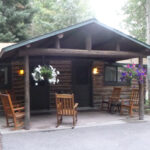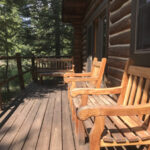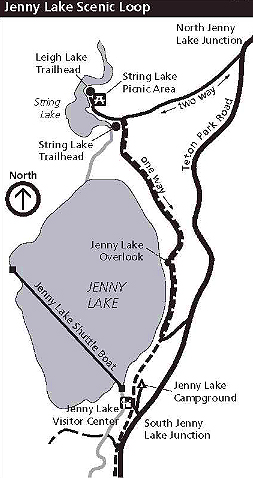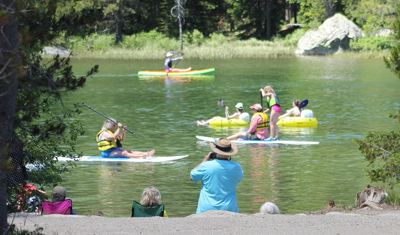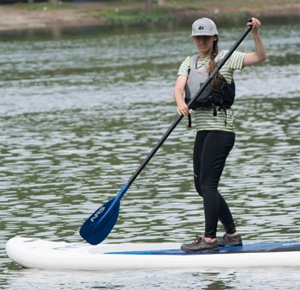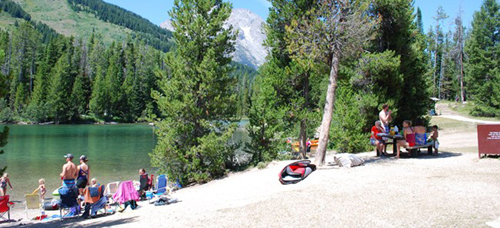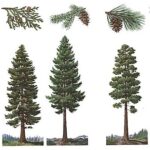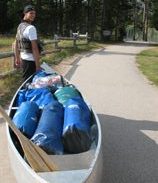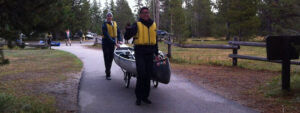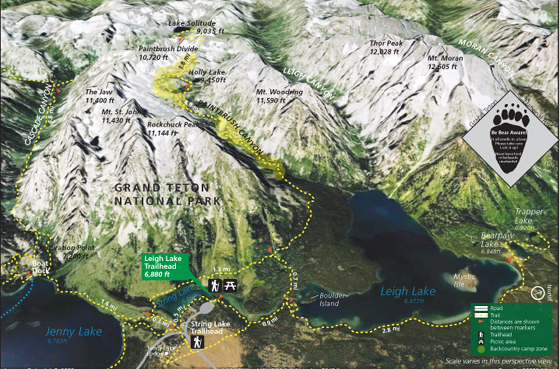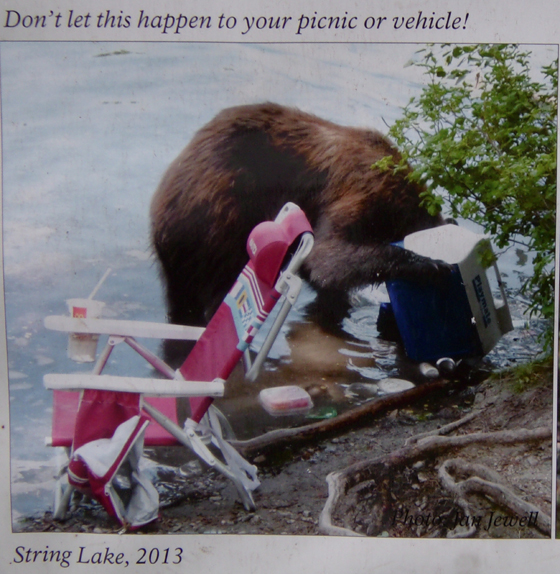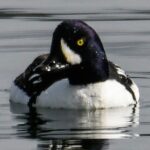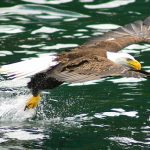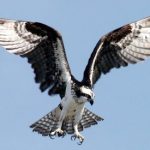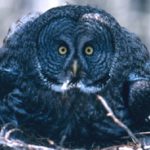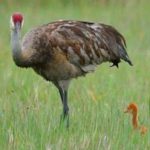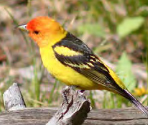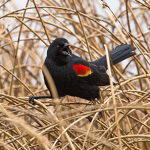String Lake in Grand Teton National Park is located right up next to the mountains.

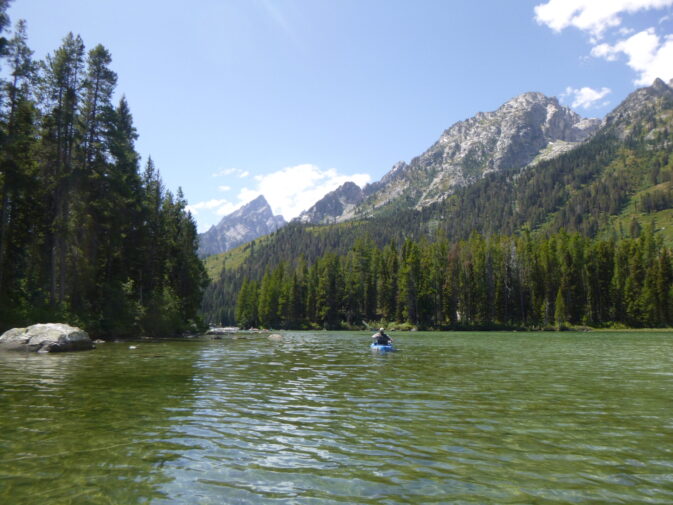
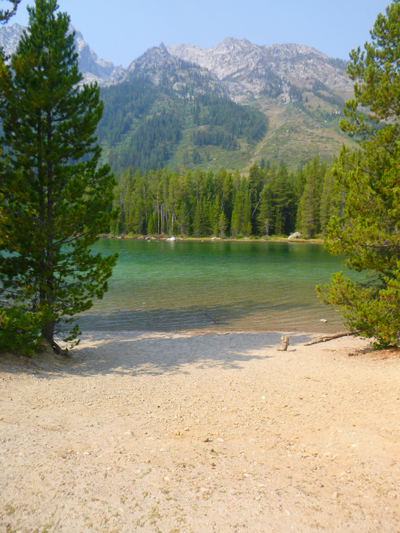
The three parking lots at String Lake are shown in an aerial photo in the upper right hand side of the map below
and described, with more photos and maps, on this webpage.
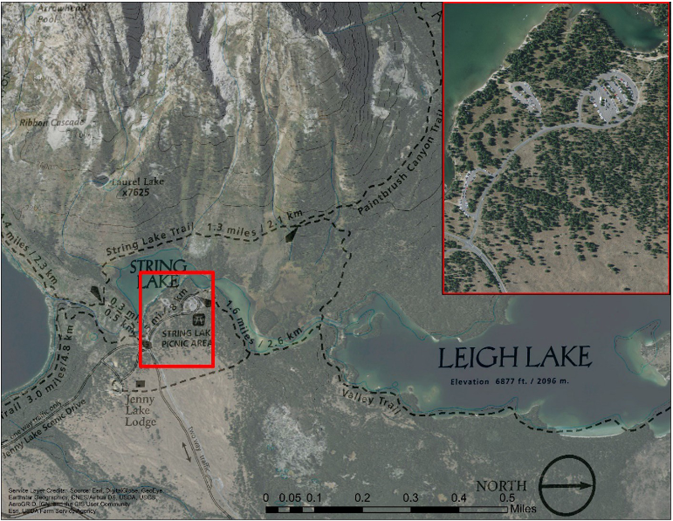
As you head for String Lake, after you turn off the Teton Park Road at the North Jenny lake junction you will be on a road that often has
No Roadside Parking designations and log barriers to prevent roadside parking, due to the heavy visitor use at String Lake.
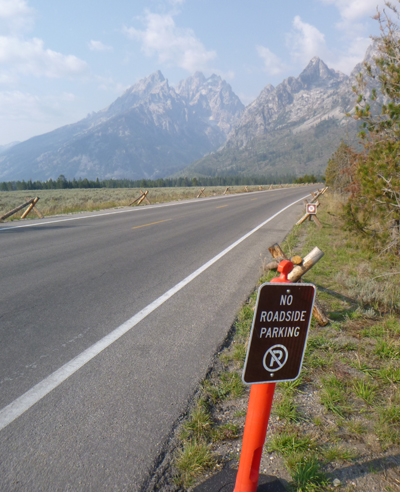
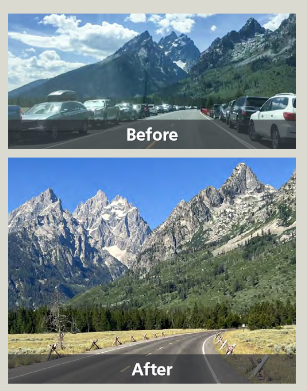
Note that if you miss the right turn into the String Lake area, you will be on a one way, one lane road road after it passes the entrance to Jenny Lake Lodge.
You can choose to drive one-way, one lane, 3 mile / 4.8 km long, Jenny Lake Scenic Drive (aka Jenny Lake Loop road) after your visit to the String Lake area instead of going back the way you came in.
Here is what the road looked like before they made it into one lane for vehicles, and another lane only for bikes:
and here is what it looks like now:
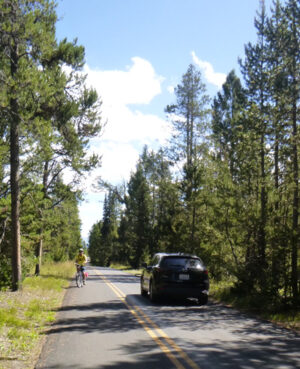
Along the way you will find Jenny Lake overlook with this view across to Cascade Canyon:
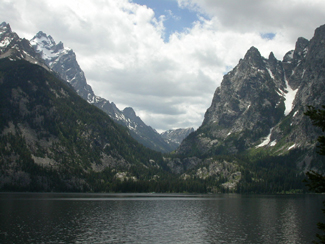
and with the often at midday slow traffic, or even backed up traffic when people try to enter the small parking area at the Jenny Lake overlook.
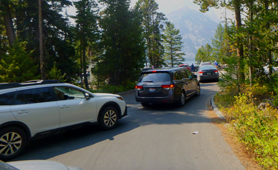

String Lake isn’t really a lake, it’s actually a wide section of a river. But its slow current makes it feel and look like a lake. It is often called a flat water lake because there are less waves, but when the wind comes up in the afternoon it can have mini-waves or even whitewater.
The relatively flat, relatively not-so-cold water makes it a better swim area than many of the other lakes in Grand Teton National Park.

and great for SUPs (stand-up paddleboards) and practice paddling.
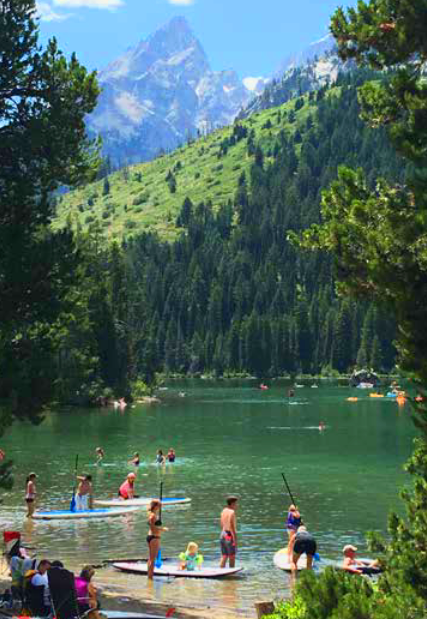
You will need a boating permit for your kayak, canoe or stand-up paddle board. The lifejacket will not get in the way of paddling a SUP:
![]()
The three String Lake paved parking lots have a total of 226 parking spaces, (18 of them oversized), with designated handicapped parking spaces and often designated with signage, parking for park service staff only. Usually closed November 1 – April 30 due to snow.
The parking lots often fill early in the day. The park service notes that “wait times for spaces are high at peak. Roadside parking is not allowed when parking lot is full.” Busy times listed by the park are from 8 a.m. to 5 p.m., very busy from 10 a.m. to 3 p.m.
The spaces reserved for oversized vehicle, or one towing a trailer, are extra long and have it painted on the pavement: “oversized vehicles only.”
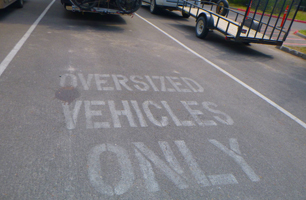
Overnight parking is only permitted for those with a backcountry permit and when you pick up your permit you give the ranger the description of the vehicle(s) you will be parking overnight.
Signage where a pathway starts, coming from the parking lot
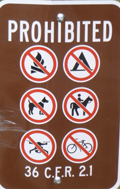
tells people that campfires, camping, dogs, horses, drones are not allowed and that bike riding is not allowed on pathways, (but you can walk your bike on the pathways and ride it on the roads.)
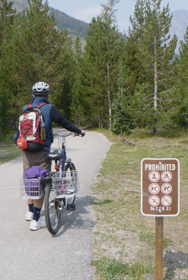
Rangers have laid branches across some of the multiple paths people wore out instead of using the paved walkways, with signs that say “restoration area.” Please don’t be one of the people who just walks right alongside and wears out a new path.
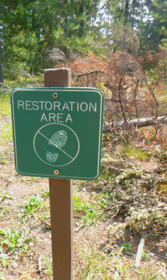

The map below shows the three main parking lots at the southern end of String Lake.
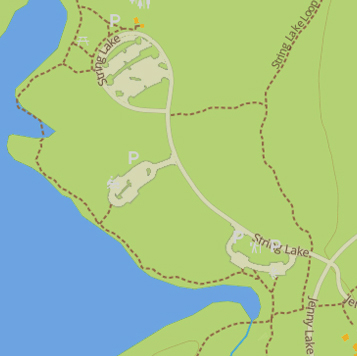
The biggest parking lot at the top of the map is the main lot for early hikers going out on the trails (see map further below of trails) and people using the lake for most lake activities (with picnic tables and bear boxes along the edge of the parking lot). The two tiny orange squares are the restrooms.
The restrooms have signage:
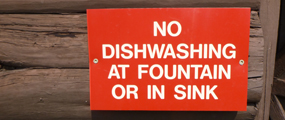
This next sign is because people do not realize how strongly food garbage smells to a bear, and that they should not leave any in the restroom trash can, but should take it to the dumpster so bears and other critters are not attracted into the restrooms:
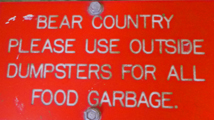
There are lots of picnic tables:
The trees lining the lakeshore and in the above photo are mostly Lodgepole Pines.
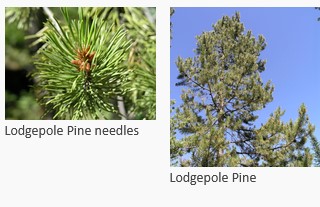
– – – – – – – – – – – – – – – – – – – – – – – – – – – – – – – – – – –
Many people think of trees the shape of the ones shown below as “pine” trees,
but only one of them is actually a pine tree and we see it in Yosemite rather than in the Rocky Mountains. If you are interested in learning more, see tree identification in Grand Teton Park.
– – – – – – – – – – – – – – – – – – – – – – – – – – – – – – – – – – –
Bears frequent the area so people need to stay next to any food they have out,
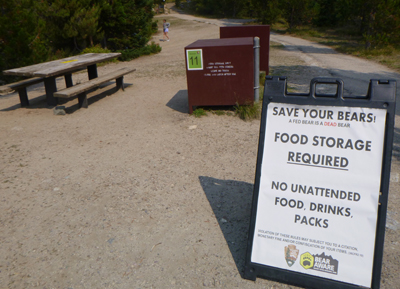
or keep food in a bear box, following the instructions on the box:
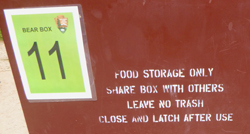
This happened right down at the beach at String Lake, when people did not keep their food within arm’s reach. The bear got into the food even with people around the area, creating a big danger:
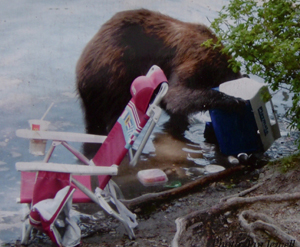
When you are about to leave, check your picnic area for microtrash
look for bandages, twist ties, fruit peels, bits of wrappers, stray potato chips, torn corners of candy bar wrappers and power bars, plastic bottle caps, bits of G.O.R.P. etc.
and maybe even pick up what others have left behind.
Grand Teton National park has an announcement that some park visitors seem to not have learned about:
“Be thoughtful of how music may affect others. Operating an audio device, such as a stereo, Bluetooth speaker, radio, or musical instrument in a manner which is unreasonable and impacts park users is prohibited by law.”
– – – – – – – – – – – – – – – – – – – – – – – – – – – – – – – – – – – – – – – – – –

The second parking lot down on the map
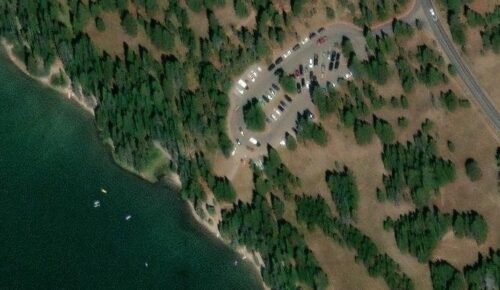
is for parking for people with canoes/kayaks to use the launch ramp,
and people are discouraged from using that lot if they will not be launching a boat.
You may find more space in the parking lot to pump air into your SUP that at the small launch beach:
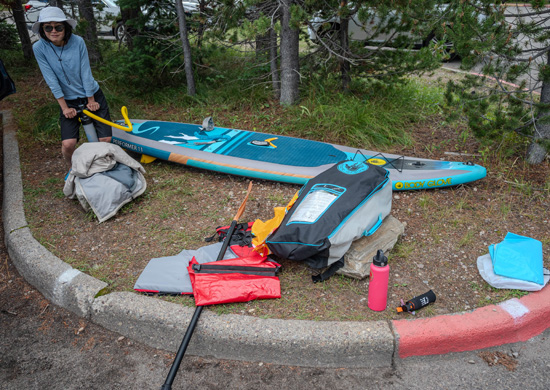
Sometimes boaters have needed to ask people picnicking or just sitting at the lakeshore at the end of the canoe launch ramp to move so they can get their canoe through to the water:
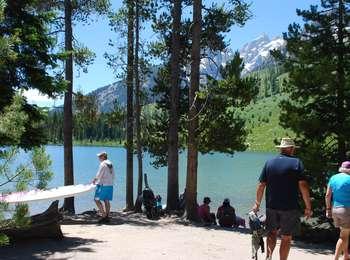
So the park service put up signs asking people to picnic elsewhere:
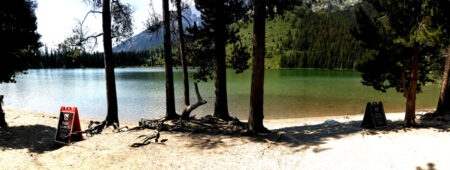
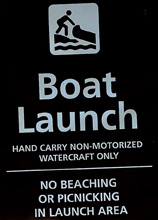
– – – – – – – – – – – – – – – – – – – – – – – – – – – – – – – – – – – – – – – – – –

The third parking lot down on the map,
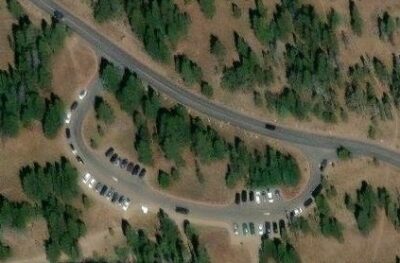
at the end of String Lake, usually used mostly by late arrival hikers and backpackers, especially those heading out on the trail across the west side of Jenny Lake towards and into Cascade Canyon.
– – – – – – – – – – – – – – – – – – – – – – – – – – – – – – – – – – – – – – – – – –
The hike around String Lake, according to the park service, takes 2-3 hours. “String Lake Loop is an easy 3.7 mi (5.6 km) loop hike with 540 ft (160 m) of elevation gain and an average slope of 6%. The trail on the east side of the lake is relatively flat, with obstacles such as exposed roots and rock. The west side of the trail includes elevation gain to a ridge overlooking String Lake. ”
If you go a bit off-trail you might be able to find where the creek from String Lake empties into Jenny Lake:
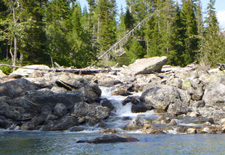
The NPS photo trail map below has Jenny Lake on the left, String Lake in the center, Leigh Lake on the right and the trails leading from each of these three lakes:
__________________________________
There are no restrooms, privies or outhouses on the trails going from String Lake.
To truly be able to leave no trace and follow backcountry rules about digging your personal latrine hole the proper distance from water, you will need to know how far 200 feet is.
Lay out a tape measure at home and walk it and count your paces.
How to poop in the woods.
__________________________________
Each year that the De Anza Outdoor Club has gone paddling in the Tetons we have launched on String Lake. Sometimes we go there for a beginners paddling lesson, sometimes we have portaged (carrying the craft) to Leigh Lake.
Parts of String ‘Lake’ are so shallow that you can easily get stuck. You might see lines in the sand on the bottom that the keels of canoes and kayaks have left. And we frequently find prints from elk, deer or moose.
Here a trip member balances on his kayak after it got stuck.
If it were not firmly stuck in the mud, it would be dangerous to stand up in or on.
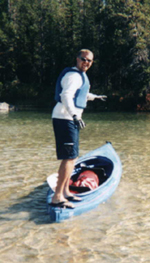
__________________________________
During a thunderstorm, don’t swim, paddle, take a shower or use a sink, including washing dishes. Don’t talk on a land line phone. Don’t use your I pod. Don’t get zapped! Please read Thunderstorm and lightning safety
__________________________________
Food storage and staying close to your food is important even at a picnic area. Unfortunately, people regularly leave food unattended.
A park service study of people at String Lake found:
“Study technicians observed and recorded Behaviors of Interest (BOI) along the eastern shore of String Lake. BOI include any person violating GRTE rules and regulations and/or Leave no Trace Principles, and people engaging in any behavior that may negatively impact another user’s experience.
The most frequent behaviors are improper food storage (i.e. leaving food unattended), loud human-caused noise making, hiking off trail, and lacking a visible personal floatation device while on a watercraft. Each behavior accounts for about 20% of rule-breaking behavior. These behaviors are more prominent in the earlier part of the sampling season (mid-July through mid- August). Interestingly, as the sampling season progresses into mid-August, the frequency of improper food storage decreases to 7%, while loud human-caused noise increases to 33%.”
The study also notes the number of people parking in illegal parking spaces, hiker density on trails and around the shoreline, what time of the day the parking lots filled.
It had these comments from visitors:
“During our picnic one of them left a sandwich on a plate, they were all kind of sitting here, and bird flew down and snatched the sandwich.”
“This is not wilderness. If you want wildness you need to go out a little deeper into the park.”
“You know I will admit I try not to be too judgmental. String Lake has gotten so noisy. So unbelievably noisy. I personally think even though this is really awful. The only way to deal with it, is to ban stand ups, they have taken over the lake. They come with a certain attitude: “I’m at the beach. I’m hanging out. I’m getting sun.” SL has totally shifted. It’s madness out here. Fortunately, you can head over to Leigh and escape it if you go way back by Moran because no one wants to paddle that far.”
___________________________________
An Audubon website said that at String Lake “you might see Trumpeter Swan, Barrow’s Goldeneye, Common Merganser, Common Loon, Western Grebe, American White Pelican, Osprey, and Sandhill Crane.”
At String Lake we often see Merganser ducks with chicks swimming behind mom in a row:

and sometimes many Barrows Goldeneye ducks:

![]()
Grand Teton National Park birds
has photos and details about the most common ones we can hope to see
including Bald Eagle, Red-winged Blackbird, Canada Geese, Clark’s Nutcracker, Golden Eagle, Great Blue Heron.Great Gray Owl, Harlequin duck, Loon, Magpie, Merganser, Northern Flicker (woodpecker), Osprey, Ouzel, Pelican, Peregrine Falcon, Ptarmigan, Raven, Sandhill Cranes, Steller’s Jays, Trumpeter Swan, Western Meadowlark and Western Tanager, with links to calls / songs from most of them to listen to.
and you can Download photos of over a hundred birds of Grand Teton National Park
https://www.audubon.org/climate/national-parks/grand-teton-national-park
___________________________________
 Was that a black bear or a grizzly, a coyote or a wolf or a fox we just saw?
Was that a black bear or a grizzly, a coyote or a wolf or a fox we just saw?
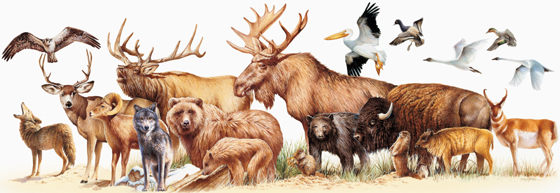 Rocky Mountain mammal size comparisons has photos and comparisons of beavers, squirrels, pika, marmot, elk, moose, bison, fox, coyote, wolf, golden-mantled ground squirrel, chipmunk, Red Squirrel (also known as) Chickaree, Unita Ground squirrels, bobcat, lynx, mountain lion (cougar), pine marten, mountain goats, bighorn sheep, pronghorn, grizzly and black bears, tundra swan, trumpeter swan, adult and juvenile Bald Eagles.
Rocky Mountain mammal size comparisons has photos and comparisons of beavers, squirrels, pika, marmot, elk, moose, bison, fox, coyote, wolf, golden-mantled ground squirrel, chipmunk, Red Squirrel (also known as) Chickaree, Unita Ground squirrels, bobcat, lynx, mountain lion (cougar), pine marten, mountain goats, bighorn sheep, pronghorn, grizzly and black bears, tundra swan, trumpeter swan, adult and juvenile Bald Eagles.
__________________________________
There is no camping at String Lake.
Below this map of campgrounds in Grand Teton National Park are links to webpages with maps and pictures of each of the campgrounds. Some have recommendations for which campsite to choose.
Headwaters campground, near the Yellowstone National Park border, “offers 34 tent sites, 97 full-hookup and pull-through RV sites, and 40 Camper Cabins, and is open from June to October. . . 45-foot length limit”
Lizard Creek campground has sites on Jackson Lake, some with views across the water. This “60-site campground sits on the northern shore of Jackson Lake and offers access to the lake waters and views of the northern Teton Mountain Range.” 30-foot length limit.
Colter Bay campground Campsites include “338 individual campsites, 12 large group sites, 10 hiker-bicycler sites, and 13 electric-only ADA-accessible sites.” The campground is open from mid-May to late-September. None of these campsites are on the lake and none have views.
The Colter Bay RV Park includes “112 full hookup RV sites (102 Full hookup pull-through sites, 10 Full hookup back-in sites) including sewer, water, and 20-, 30-, and 50-amp electric outlets. The RV Park is open from early-May to early-October.”
Signal Mountain (86 campsites, no group sites) is the campground with some sites with views across the lake to the mountains. The campground “offers tent camping and pull-in/back-in sites for RVs or trailers up to 30 feet. This campground offers 24 sites with 30 and 50-amp hookups which are popular during the early and late season. The campground is organized in three loops with the first loop mainly offering electrical hookup sites, and the last loop being “generator free”. Tent pads are available at select sites and all sites have picnic tables, fire rings and bear-proof food storage boxes. Parking pads and areas for tents can vary greatly in size and care should be given when selecting a site.”
“Winter conditions can linger at this campground in May. Snow is likely in many sites during early season operations. For this reason, we only guarantee certain sites will be available during May operations. We will release additional sites as we get closer to opening day and depending on snow pack. Some amenities may not be available during early season, such as fire rings and tent pads. Please plan accordingly if you are making reservations for early season.” ” Many sites are small and may not accommodate large modern RV’s or trailers. Roadways are narrow and all sites have back-in access to parking pads (there are no pull through sites). Advanced backing skills are required for certain sites. Please double check the dimensions of your particular site reservation to ensure the site will meet your equipment needs.” If you book a site your rig will not fit in, they will likely not be able to reassign you to a better site.
Jenny Lake campground, a short distance from, but not on, Jenny Lake, tents only, only one vehicle no larger than eight feet high and 14 feet long, is the first Grand Teton National Park campground to fill each day, often early in the morning.
This “tent-only campground has two loops with 51 individual campsites, three of which are ADA-compliant sites, and 10 hiker-bicycler sites.
Gros Ventre campground, 4.5 miles from Gros Ventre junction, is the closest campground to the town of Jackson (9 miles +/- Northeast). It has camping for tents and dry camping for RVs. Sites vary in size and can accommodate RVs up to 45ft. 279 individual campsites, 4 large group sites, and 39 electric-only sites, 10 of which are ADA-accessible. It is usually open from late-April to early-October. It has cottonwood trees and sagebrush along the Gros Ventre river. You might see a moose wander through the campground and sometimes can find one along the river.
——————————————————————-
The author of this webpage, (written as a reading assignment for my students), does not give any warranty, expressed or implied, nor assume any legal liability or responsibility for the accuracy, completeness, or usefulness of any information, product, or process included in this website or at websites linked to or from it. Users of information from this website assume all liability arising from such use.
